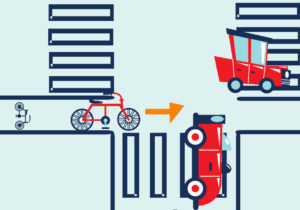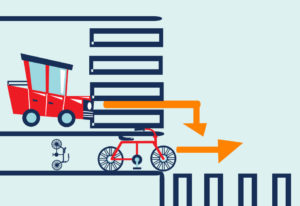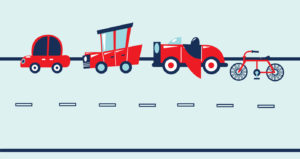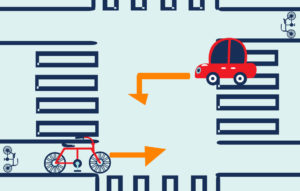Common Bicycle Collisions in the Washington DC Area

Right Cross
The right cross occurs when a vehicle crosses the cyclist’s path from the right. As you can see from the diagram, this commonly happens when a car is exiting from a side street, parking lot, or driveway. This type of collision often occurs when a motorist is looking for other vehicles, but not bicyclists, when deciding whether it is safe to enter the roadway. Another scenario where a right cross is common is when a vehicle intends to make a right turn on a red light and fails to see an oncoming bicyclist proceeding straight with the green light.
Avoiding the Right Cross
Motorists can avoid the right cross by not entering a roadway without checking for both vehicles AND bicyclists. Motorists should also be aware that nosing into a roadway, or inching forward while waiting for other vehicles to pass, may inadvertently put the motorist in the bicyclist’s path. Bicyclists can be more vigilant near intersections and parking lot exits, but oftentimes a right cross is hard to foresee.

Right Hook
The right hook occurs when a vehicle traveling in the same direction as a bicyclist decides to make a right turn into the bicyclist who is proceeding straight. A right hook can happen near street intersections, parking lot entrances, or driveways. When I talk with people who have been involved in this kind of bike collision, the root problem is usually either the motorist does not see the bicyclist (even though the bicyclist is there to be seen) or the motorist races past a bicyclist and fails in the attempt to turn in front of the bicyclist. I think for some motorists, bike lanes can increase the chance of a right hook because the motorist does not foresee that the bicyclist may be proceeding straight through the intersection.
Avoiding the Right Hook
Motorists can avoid a right hook by safely moving to the far right side of the road when intending to make a right turn. While driving a vehicle in a bike lane is not good, it is considered good practice to first merge into the bike lane before making a right turn. Bicyclists can help protect themselves from a right hook by being extra aware near intersections and feeling free to take the lane to raise your visibility to vehicles approaching from behind you.

Dooring
Dooring occurs when a motorist parked along the side of the road opens the door directly in the path of an oncoming bicyclist. If you ride a bike in a city like Washington, DC, you know that dooring is an ever-present threat. Most streets in downtown areas permit parallel parking, which is where the threat of being doored arises. Often bicyclists travel on a part of the city street that has parallel parked cars on one side and moving traffic on the other. If a motorist opens his door into this narrow strip of asphalt, the bicyclist has the uneviable choice (if there is enough warning to even make a choice) of moving out into traffic or striking the door. Often there is no warning. I’ve seen it happen and it is a cringe-inducing to watch.
Avoid Dooring
Motorists can avoid dooring a bicyclist by looking behind them while they open a door into traffic. There is a common practice in some bicycle-friendly countries to where motorists use their right hand to open the door when parallel parked, which naturally causes one’s body to look over one’s left shoulder, increasing the chances of seeing an oncoming bicyclist. Bicyclists face tough choices when trying to avoid being doored. A cyclist can ride farther out in traffic and risk being hit by a moving vehicle, or ride closer to parallel parked cars and risk being doored. Sad to say, but it’s largely a matter of luck.

Left Cross
The left cross occurs when a vehicle crosses the cyclist’s path from the left. This usually happens when a vehicle is making a left turn across oncoming bicycle traffic. Like many other bicycle collisions, the root problem when a left cross occurs is that the motorist is looking out for other vehicles, but fails to see an oncoming cyclist on the far right side of the road or in the bike lane.
Avoiding the Left Cross
Motorists can avoid the left cross by remembering to check for both oncoming vehicles AND bicycles. On some Washington, DC streets, motorists should remember that bike lanes may permit bicyclists to travel in both directions, even if vehicle traffic only flows one way (such as on 15th Street, NW). Bicyclists can be more vigilant near oncoming vehicles making left turns. This is also a scenario when bicycle lights and brightly colored clothing can be helpful, since the bicyclist is often in full view of the motorist immediately before the collision.
